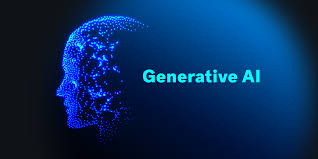Gen AI Implementation Guide: A Step-by-Step Guide for Enterprise Integration - Part I
 Rohitha Elsa Philip
Rohitha Elsa Philip
Artificial Intelligence has become an indispensable tool for modern enterprises, driving efficiency, innovation, and competitive advantage. However, as the demand for more human-like interactions and outputs grows, traditional AI systems have begun to show their limitations. Enter Generative AI (Gen AI) — a new frontier in artificial intelligence that promises to bridge this gap by creating outputs that mimic human creativity and intuition.
Traditional AI systems have enabled significant advancements in automation and data analysis, but the emergence of Generative AI (Gen AI) is set to revolutionize the way enterprises interact with technology. Gen AI goes beyond conventional AI by focusing on generating human-like outputs and interactions.
Implementing Gen AI applications within enterprise environments holds the promise of revolutionizing various business functions, from customer engagement to product development. However, this transformation requires more than just technological prowess; it demands a strategic roadmap that guides enterprises through the complexities of adoption.
However, implementing Gen AI applications in enterprise settings requires careful planning, strategic execution, and a comprehensive understanding of its capabilities and implications. This guide serves as a roadmap for enterprises looking to harness the power of Gen AI and integrate it seamlessly into their operations.
From identifying suitable use cases and preparing data to deploying and optimizing Gen AI models, this roadmap provides step-by-step guidance on how to navigate the complexities of Gen AI implementation. By following these principles and best practices, enterprises can unlock new opportunities for innovation, efficiency, and growth in the era of Gen AI.
Let’s embark on this journey together and explore how Gen AI can transform your enterprise into a beacon of intelligent and human-like interaction.
1. Understanding Gen AI
Definition:
Generative AI, or Gen AI, is a subset of artificial intelligence (AI) that focuses on creating outputs that mimic human-like behavior, creativity, and intuition. Unlike traditional AI systems that primarily analyze data and make predictions or classifications based on patterns, Gen AI goes a step further by generating new content, such as images, text, audio, or even entire conversations.
Differentiation:
Understanding how Gen AI differs from traditional AI is crucial for enterprises to grasp its potential applications and benefits:
Output Generation: Traditional AI systems are typically discriminative models that classify or predict based on existing data patterns. In contrast, Gen AI is generative, meaning it can create new data that resembles the training data but is not limited to it.
Creativity and Intuition: While traditional AI systems excel at tasks with well-defined rules and patterns, Gen AI can exhibit more creativity and intuition, allowing it to produce outputs that are novel, diverse, and even surprising.
Human-like Interaction: Gen AI enables more natural and human-like interactions, making it suitable for applications such as conversational agents, content creation, and personalization.
Potential Applications: Gen AI can be applied across various domains, including but not limited to:
- Content Creation: Generating text, images, music, and videos.
- Conversational AI: Creating chatbots and virtual assistants capable of engaging in meaningful conversations.
- Personalization: Tailoring products, services, and recommendations to individual preferences.
- Decision Support: Providing insights, recommendations, and creative solutions to complex problems.
Understanding these differences empowers enterprises to envision how Gen AI can enhance their operations, drive innovation, and deliver unique experiences to customers and stakeholders.
2. Assessment of Current Infrastructure:
Data Infrastructure
Assessing the quality and quantity of your data is essential because Gen AI heavily relies on data for training its models. Here’s what this entails:
- Quality: Evaluate the quality of your data in terms of accuracy, completeness, consistency, and relevance. Ensure that your data is clean, free from errors or biases, and suitable for training Gen AI models.
- Quantity: Determine the volume of data available for training Gen AI models. More data generally leads to better model performance, so having a sufficient amount of high-quality data is crucial.
- Structure and Accessibility: Ensure that your data is structured in a way that is conducive to training Gen AI models. This may involve organizing data into formats such as text, images, or audio and making it easily accessible for training processes.
- Data Governance: Establish data governance policies to ensure data security, privacy, and compliance with regulations. This includes defining who has access to the data, how it’s used, and how long it’s retained.
Technology Stack:
Evaluate your existing AI technologies and infrastructure to determine their compatibility with Gen AI applications. Here’s what to consider:
- AI Technologies: Assess the capabilities of your current AI technologies, including frameworks, libraries, and tools. Determine whether they support generative models like those used in Gen AI applications or if upgrades or additional tools are necessary.
- Infrastructure: Evaluate your computational infrastructure, including hardware (e.g., GPUs, TPUs) and software (e.g., cloud platforms, on-premises servers). Gen AI models often require significant computational resources for training and inference, so ensure your infrastructure can support the workload.
- Scalability: Consider whether your existing infrastructure can scale to accommodate the increased demands of Gen AI applications. This includes both the ability to handle larger datasets and the computational requirements of training and deploying more complex models.
- Integration: Assess how well your current technology stack integrates with Gen AI tools and platforms. Seamless integration is essential for efficient development, deployment, and management of Gen AI applications within your enterprise.
By thoroughly assessing your data infrastructure and technology stack, you can identify any gaps or areas for improvement that may impact the successful implementation of Gen AI applications. This allows you to address these challenges proactively and ensure that your infrastructure is capable of supporting the requirements of Gen AI.
3. Identifying Potential Projects:
Identifying potential projects involves selecting use cases or tasks within the enterprise where Gen AI can add significant value. This process typically includes conducting a feasibility study and ROI analysis for each project.
Feasibility Study:
A feasibility study is conducted to determine the viability and potential success of implementing Gen AI for a specific project. Here’s how it works:
- Creativity, Personalization, or Natural Language Understanding: Gen AI excels in tasks that require creativity, personalization, or natural language understanding. Identify areas within your enterprise where these capabilities could be leveraged to enhance processes or interactions.
- Task Suitability: Evaluate the tasks or processes within your organization that could benefit from Gen AI. These could include content generation, customer service, product recommendation, sentiment analysis, or decision support.
- Data Availability: Assess the availability and quality of data relevant to the identified tasks. Gen AI heavily relies on data, so ensure that sufficient and high-quality data is accessible for training the models.
- Technical Requirements: Consider the technical requirements and infrastructure needed to implement Gen AI for the identified tasks. Ensure that your organization has the necessary resources and expertise to develop, deploy, and maintain Gen AI solutions.
- Regulatory and Ethical Considerations: Evaluate any regulatory or ethical considerations associated with the proposed projects. Ensure compliance with data privacy regulations and consider potential biases or ethical implications of using Gen AI in specific contexts.
ROI Analysis:
Estimating the return on investment (ROI) for each potential project helps prioritize initiatives and allocate resources effectively. Here’s how to conduct an ROI analysis:
- Cost Reduction: Estimate the potential cost savings that could be achieved by implementing Gen AI. This could include reductions in labor costs, operational expenses, or resource utilization.
- Revenue Generation: Identify opportunities for revenue generation through increased sales, improved customer engagement, or new product/service offerings enabled by Gen AI.
- Improved Customer Satisfaction: Assess the potential impact of Gen AI on customer satisfaction metrics, such as response time, accuracy, personalization, and overall user experience.
- Quantitative and Qualitative Metrics: Consider both quantitative metrics, such as cost savings and revenue growth, and qualitative metrics, such as customer feedback and brand perception, in your ROI analysis.
- Long-Term Benefits: Take into account the long-term benefits and strategic advantages that Gen AI projects may bring to the organization, such as improved competitiveness, market positioning, and innovation capabilities.
By conducting a feasibility study and ROI analysis for potential projects, enterprises can identify the most promising opportunities for implementing Gen AI and prioritize initiatives that offer the greatest value and return on investment.
4. Data Preparation:
Data preparation is a critical step in implementing Gen AI applications. It involves gathering, refining, and labeling datasets to ensure they are suitable for training Gen AI models.
Data Collection:
Gathering diverse and high-quality datasets relevant to your chosen projects is essential for training accurate and effective Gen AI models. Here’s how it works:
- Relevance: Collect data that is relevant to the specific tasks or use cases you identified during the project identification phase. Ensure that the data covers a wide range of scenarios and variations that the Gen AI model may encounter in real-world applications.
- Diversity: Aim for diversity in your datasets to capture a wide range of perspectives, demographics, and scenarios. This diversity can help improve the robustness and generalization of the Gen AI models.
- Quality: Prioritize data quality by ensuring that it is accurate, complete, and free from errors or biases. If necessary, clean and preprocess the data to remove noise, inconsistencies, or irrelevant information.
- New Data vs. Existing Data: Depending on the availability of data, you may need to collect new data specifically for your Gen AI project or refine existing datasets to make them suitable for training.
Data Labeling:
Properly labeling your data is crucial, especially for supervised learning tasks where the model learns from labeled examples. Here’s how to ensure accurate data labeling:
- Supervised Learning: If your Gen AI project involves supervised learning, where the model learns from labeled data, ensure that your data is properly labeled with relevant annotations or tags.
- Accuracy and Consistency: Labels should be accurate and consistent across the dataset to ensure the reliability of the training process. Use clear labeling guidelines and quality control measures to maintain consistency.
- Annotation Tools: Utilize annotation tools or platforms to streamline the labeling process and ensure efficiency and accuracy. These tools can help annotate large volumes of data more effectively while reducing human error.
- Quality Assurance: Implement quality assurance checks to verify the accuracy of labeled data and identify any errors or inconsistencies. This may involve manual review, automated validation, or crowd-sourced feedback.
- Iterative Improvement: Continuously refine and update your labeled datasets based on feedback and model performance. As your Gen AI models improve, you may discover the need for additional or refined labels to enhance accuracy and effectiveness.
By carefully collecting diverse and high-quality datasets and ensuring accurate labeling, enterprises can lay the foundation for training robust and effective Gen AI models that can deliver meaningful insights and value across various applications.
Subscribe to my newsletter
Read articles from Rohitha Elsa Philip directly inside your inbox. Subscribe to the newsletter, and don't miss out.
Written by

Rohitha Elsa Philip
Rohitha Elsa Philip
I am a versatile professional with nearly 11 years of multicultural experience spanning brand communication, digital content strategy, mentoring, conceptualization, IT administration, digital marketing, technical expertise, and creative content writing.